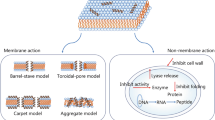Abstract
Among 31 3,4-dihydro-s-triazinobenzimidazole derivatives tested 12 compounds showedin vitro antimicrobial activity against G+ bacteria. Best results were obtained with substances containing naphthyl or halogenated phenyl group on the triazine ring. The tested derivatives had no significantin vitro antimicrobial activity against either the used G− species or fungi.
Similar content being viewed by others
References
Abdel-Rahman R.M., Seada M., El-Gendy Z., Islam I.E., Mahmoud M.N.: Synthesis of some new 4,6-disubstituted 1,2,4-triazin-3,5(2H)diones and related compounds of potential antifungal activity.Farmaco 48, 407–416 (1993).
Badawey E.A.M., Kappe T.: Synthesis andin vitro anti-HIV activity of certain 2-(1H-benzimidazol-2-ylamino)pyrimidin-4(3H)-ones and related derivates.Arch. Pharm. Pharm. Med. Chem. 330, 59–62 (1997).
Fekete-Forgács K., Gyüre L., Lenkey B.: Changes of virulence factors accompanying the phenomenon of induced fluconazole resistance inCandida albicans.Mycoses 43, 273–279 (2000).
Holla B.S., Sarojini B.K., Gonsalves R.: Synthesis of some new biologically active thiadiazolotriazinones.Farmaco 53, 395–398 (1998).
Jantová S., Greif G., Pavlovičová R., Čipák L.: Antibacterial effect of some 1-substituted 1,2,4-triazoles.Folia Microbiol. 43, 75–78 (1998).
Jantová S., Špirková K., Staňkovský S., Duchoňová P.: Antibacterial effect of some substituted tricyclic quinazolines and their synthetic precursors.Folia Microbiol. 43, 187–190 (1999).
Jantová S., Greif G., Špirková K., Staňkovský S., Oravcová M.: Antibacterial effect of trisubstituted quinazoline derivatives.Folia Microbiol. 45, 133–137 (2000).
Martin D., Graubaum H., Kempter G., Ehrlichmann W.: Umsetzungen von 2-Guanidino-benzimidazol mit elektrophilen Reagentien.J. Prakt. Chem. 323, 303–310 (1981).
Nesměrák K., Pelouchová H., Všetečka V., Němec I., Gabriel J.: Antifungal effects of new heterocyclic compounds, 6H-pyrimido[2,1-a]isoindole derivatives.Folia Microbiol. 43, 39–43 (1998).
Pócsi I., Sámi L., Letter É., Majoros L., Szabó B., Emri T., Pusztahelyi T.: Searching for new-type antifungal drugs.Acta Microbiol. Immunol. Hung. 48, 533–543 (2001).
Serafin B., Borkowska G., Glowczyk J., Kovalska Y., Rump S.: Potential antihypertensive benzimidazole derivates.Polon. J. Pharmacol. Pharm. 41, 89–96 (1989).
Strigáčová J., Hudecová D., Varečka L'., Lásiková A., Végh D.: Some biological properties of new quinoline-4-carboxylic acid and quinoline-4-carboxamide derivatives.Folia Microbiol. 45, 305–309 (2000).
Neu H.C.: The crisis in antibiotic resistance.Science 257, 1064–1073 (1992).
Author information
Authors and Affiliations
Corresponding author
Rights and permissions
About this article
Cite this article
Gulyás, G., Emri, T., Simon, A. et al. In vitro antimicrobial activity of 3,4-dihydro-s-triazinobenzimidazole derivatives. Folia Microbiol 47, 29–31 (2002). https://doi.org/10.1007/BF02818561
Received:
Issue Date:
DOI: https://doi.org/10.1007/BF02818561




